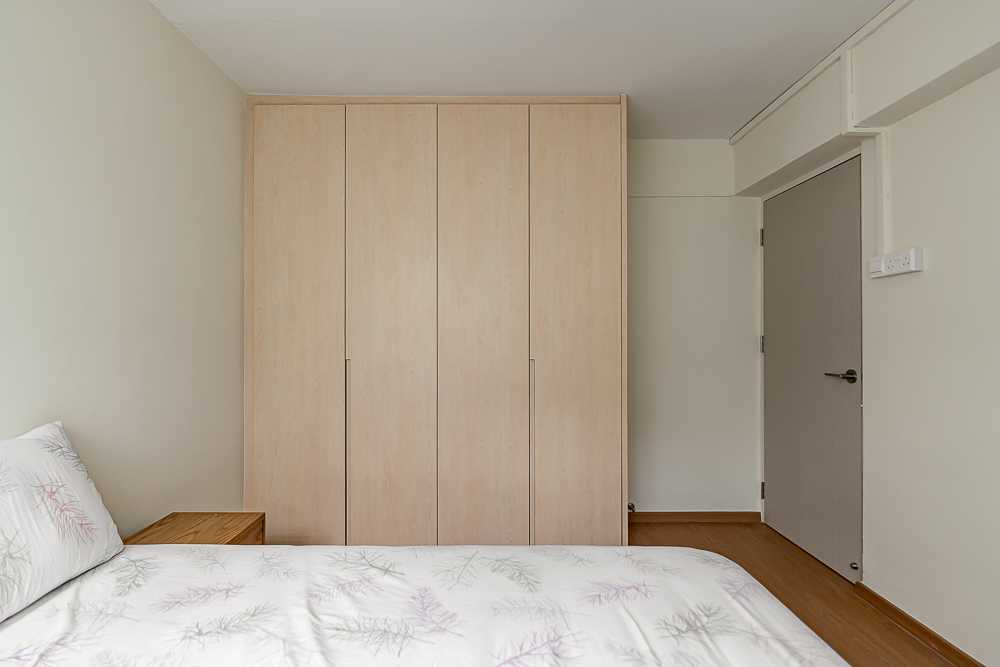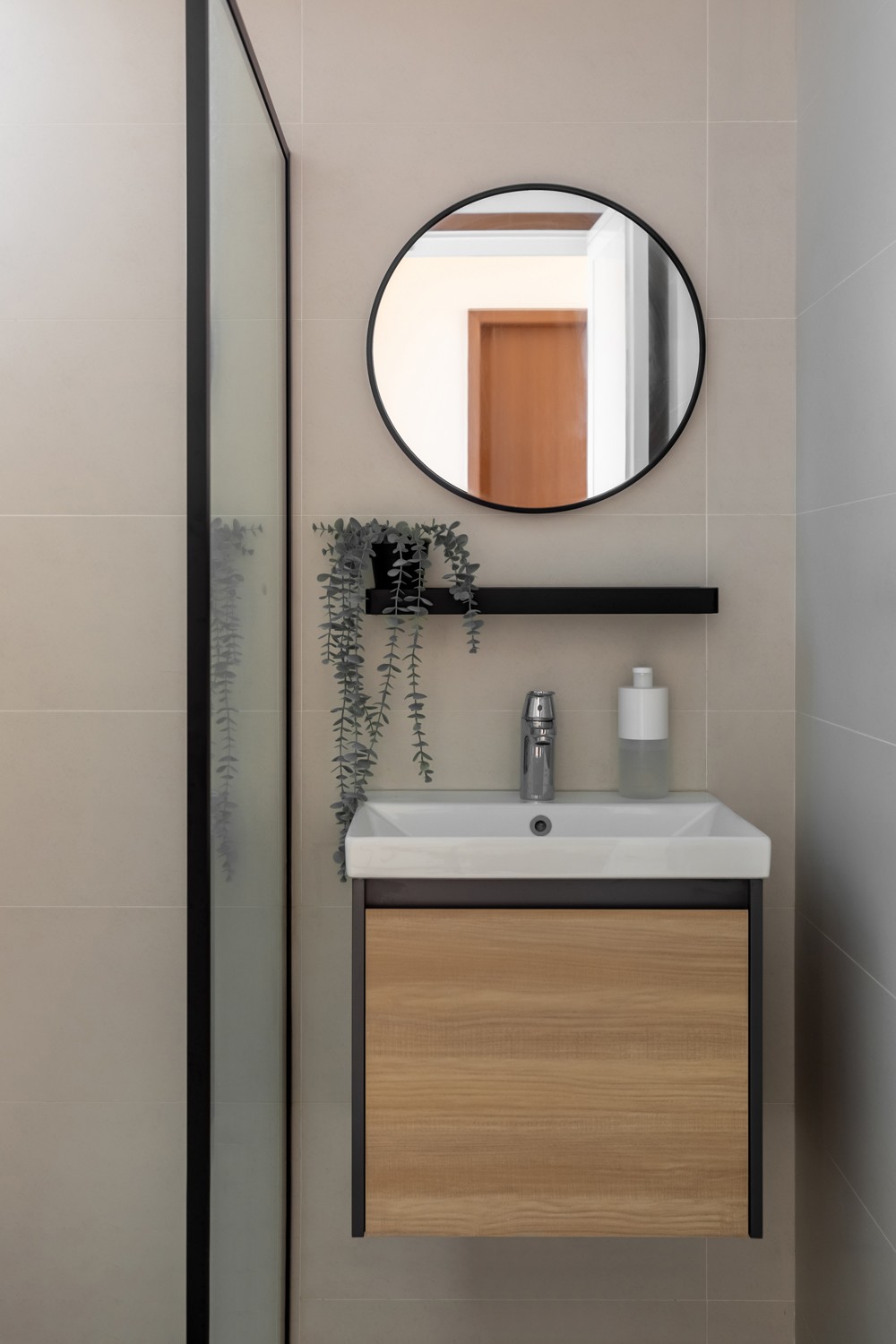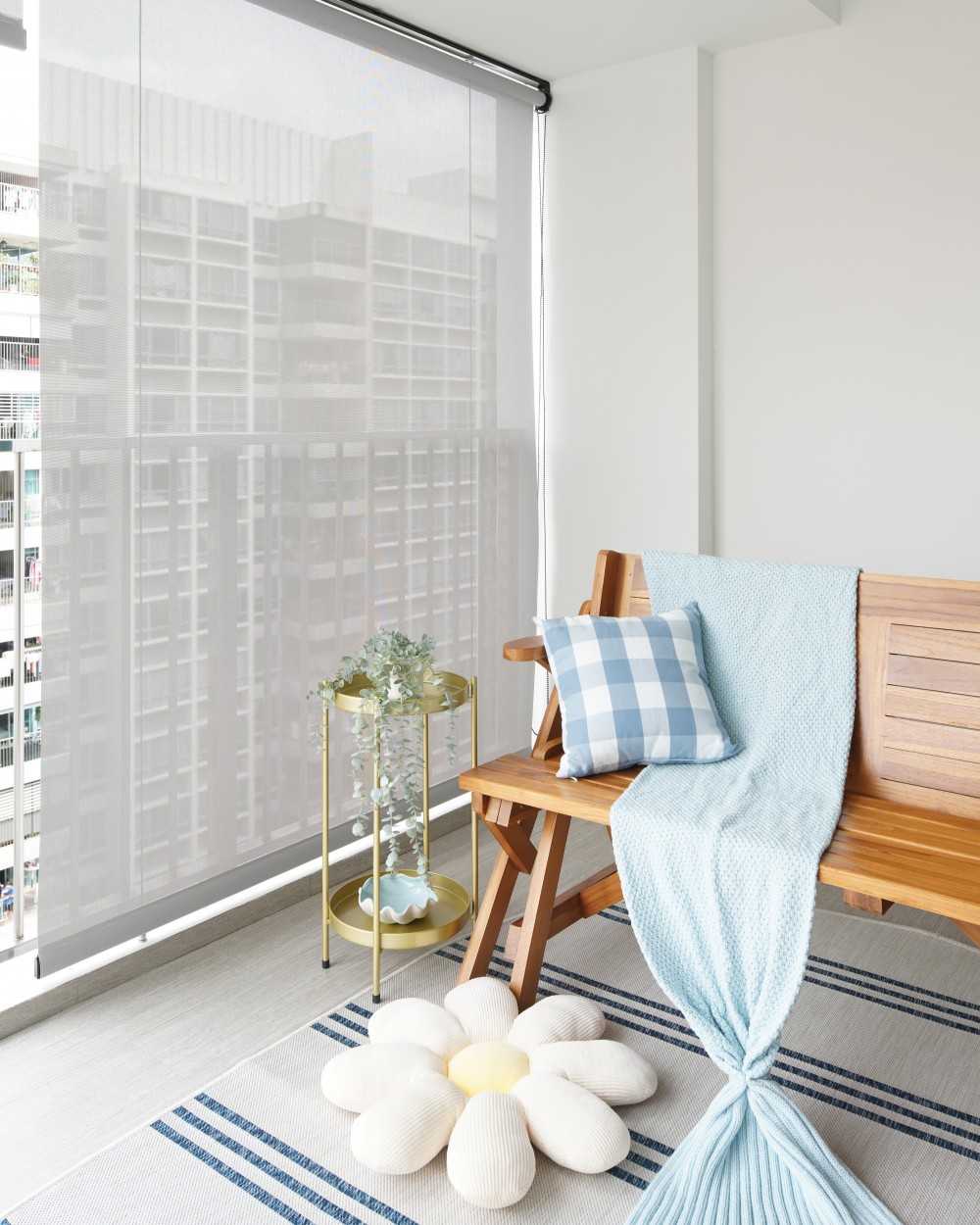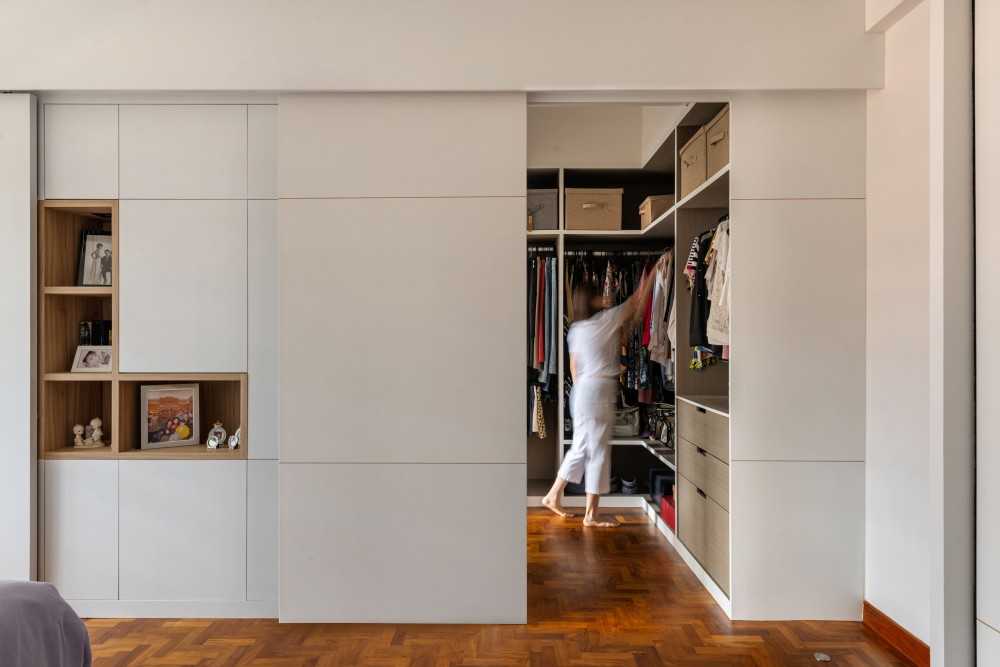How Often Should You Clean At Home?
If you’re a new homeowner, you might not know how often you need to clean or perform each chore at home.
For example: how often do you need to clean your sofa? How often do you need to clean your rugs?
In this article, we’ll share a comprehensive guide on when and how to clean your home.
Read on for more!
Living Room
The living room is often the heart of a home, where relaxation and entertainment intersect.


622B Tampines ($50,000) by JP Atelier Pte Ltd
Keeping this space clean not only ensures a welcoming atmosphere but also promotes comfort for gatherings with family and friends.
Dusting and polishing furniture
How often: Aim for dusting furniture weekly to prevent the buildup of allergens and dust mites.
Regular dusting is essential to maintain a clean living room environment. Dust particles, including allergens and dust mites, settle on furniture surfaces, leading to potential respiratory issues and allergies. Dusting weekly significantly reduces the accumulation of these particles, promoting a healthier space for your family.
How to do it: Use a microfiber cloth or duster to gently remove dust from surfaces. Microfiber cloths are highly efficient in capturing and holding onto dust particles.
Pay attention to areas that often accumulate dust, such as table edges, crevices, or ornate designs. Use a smaller, softer brush or attachment for intricate details.
For wood furniture, consider using furniture polish sparingly to bring back its shine.
Vacuuming
How often: Vacuum high-traffic areas at least twice a week and other areas once a week to eliminate dirt and debris.
Regular vacuuming is crucial to maintain a clean living room environment. High-traffic areas accumulate dirt, debris, and pet dander more rapidly, so vacuuming these zones more frequently helps prevent buildup and keeps the space cleaner.
If you have a robot vacuum, take advantage of its convenience to elevate your cleaning routine.
These automated devices can be programmed to vacuum while you’re away from home, allowing for more frequent cleaning sessions without requiring your direct involvement. You can program the robot vacuum to operate once a day or as frequently as needed, ensuring that your floors are continuously maintained, especially in high-traffic areas.
How to do it: Start from the farthest corner of the room and vacuum in overlapping strokes. Pay extra attention to edges and under furniture.
Wiping down electronics and surfaces
How often: Wipe down surfaces where germs accumulate every few days, especially remote controls, switches, and tabletops.
Frequently touched surfaces in the living room are hotspots for germ accumulation, particularly items like remote controls, light switches, and tabletops. Cleaning these areas every few days helps minimize the spread of germs and maintains a hygienic environment in your living space.
How to do it: Use a microfiber cloth slightly dampened with a gentle cleaner suitable for electronics to avoid damaging screens or surfaces. Alternatively, you can use disinfectant wipes that are safe for electronic surfaces.
Kitchen
The kitchen serves as a hub for culinary adventures and family meals.


Tengah Plantation Cres ($35,000) by Co1 Studio
You’ll want to make sure this area is clean because it’s used to prepare food – it’s perhaps the most important space in your home to keep clean!
Wiping down countertops
How often: Wipe down countertops after each meal preparation to prevent bacterial growth and maintain a clutter-free workspace.
Consistently wiping down countertops after meal preparation is essential for maintaining a hygienic kitchen environment. Doing so not only removes food debris and spills but also prevents the growth of bacteria, ensuring a clean and safe food preparation area.
How to do it: Wipe down countertops with a mild cleaner and a cloth or sponge, ensuring they’re dry to prevent water stains.
Sanitizing sinks
How often: Disinfect sinks and faucets daily to prevent the spread of germs.
Daily disinfection of sinks and faucets is crucial to maintaining a clean and hygienic kitchen environment. These areas are frequently touched and can harbor bacteria, making regular disinfection essential in preventing the spread of germs and maintaining a healthy space for food preparation.
How to do it: Clear the sink of any dishes or debris. Rinse the sink and faucet with warm water to remove loose dirt or food particles.
Spray the disinfectant directly onto the sink and faucet surfaces. Ensure even coverage, focusing on areas prone to frequent contact, such as handles, knobs, and around the drain.
Let the disinfectant sit on the surfaces for the recommended contact time specified on the product label or for at least a few minutes to effectively kill germs.
Use a sponge or cloth to scrub the surfaces, paying attention to any visible stains or buildup. Pay extra attention to grooves, seams, and around the edges of the sink.
After scrubbing, rinse the sink and faucet thoroughly with clean water to remove any residue from the disinfectant.
Use a dry cloth or paper towel to dry the sink and faucet. This step helps prevent water spots and ensures a clean and shiny finish.
Wiping down appliances
How often: Wipe down appliances weekly to prevent grease buildup and maintain their longevity.
Wiping them down helps reduce the buildup of grease, grime, and food residue, ensuring they remain in good condition and prolonging their lifespan.
How to do it: Use appropriate cleaners for each appliance and a microfiber cloth to remove fingerprints and spills. For stainless steel surfaces, use a stainless steel cleaner or a mild solution of dish soap and warm water. For glass or ceramic surfaces, use a suitable cleaner for those materials.
Mopping floors
How often: Mop kitchen floors weekly.
How to do it: Start by removing any rugs or mats from the kitchen floor. Before mopping, sweep or vacuum the bathroom floor to remove loose dirt, hair, and debris.
Mop the entire kitchen floor, starting from one corner and working your way towards the exit. Periodically rinse the mop in the cleaning solution to prevent spreading dirt.
Bedroom
The bedroom is a sanctuary for rest and rejuvenation.


12 Holland Ave ($28,000) by Dan Avenue Pte Ltd
Changing bedding and pillowcases
How often: Change bedding and pillowcases weekly to prevent dust mites and allergens.
Regularly changing bedding is essential in preventing the accumulation of dust mites, allergens, and skin cells. Weekly changes help maintain a clean and hygienic sleeping environment, reducing the risk of allergies and promoting better sleep quality.
How to do it: Wash bedding in hot water to effectively remove dust and dirt. Follow the care instructions for drying. If possible, use a dryer on a high heat setting to further eliminate any remaining dust mites. Alternatively, hang bedding outside in direct sunlight, as UV rays can help kill germs.
Mopping floors
How often: Mop bedroom floors weekly.
How to do it: Start by removing any rugs or mats from the bedroom floor. Before mopping, sweep or vacuum the bathroom floor to remove loose dirt, hair, and debris.
Mop the entire bedroom floor, starting from one corner and working your way towards the exit. Periodically rinse the mop in the cleaning solution to prevent spreading dirt.
Bathroom
The bathroom is a space for personal hygiene and rejuvenation.


Boon Lay Drive ($33,000) by U-Home Interior Design Pte Ltd
Ensuring its cleanliness not only prevents the spread of germs but also creates a refreshing and inviting space.
Wiping down countertops and sinks
How often: Wipe down countertops and sinks daily to prevent water spots and bacterial growth.
How to do it: Use a bathroom cleaner or a solution of vinegar and water for natural cleaning. At the same time, wipe down faucets, handles, and any fixtures. These areas can harbor bacteria and water spots.
Cleaning and disinfecting the toilet
How often: Clean and disinfect the toilet at least twice a week to prevent bacterial growth.
How to do it: Use a toilet cleaner and a toilet brush, focusing on the bowl, seat, and exterior. Wipe down the exterior of the toilet, including the tank and base. Use disinfecting wipes or a cloth soaked in the cleaning solution. Don’t forget to clean the flush handle, as it is a commonly touched area.
Cleaning mirrors and glass surfaces
How often: Clean mirrors and glass surfaces weekly to remove toothpaste splatters and water spots.
How to do it: Begin by dusting or wiping away any loose debris or dust from the mirror surface. Use a glass cleaner and a microfiber cloth for streak-free results.
Scrubbing the shower and tub
How often: Maintaining a weekly cleaning schedule for your bathtub and shower is crucial to prevent the accumulation of soap scum, hard water stains, and other residues. This also promotes a healthier environment by eliminating potential breeding grounds for bacteria and mold.
How to do it: Spray or apply the bathroom cleaner generously on the bathtub and shower surfaces. Allow the bathroom cleaner to sit for a few minutes. This dwell time helps to break down soap scum, grime, and stains, making them easier to remove.
Use a scrub brush or sponge to scrub the bathtub and shower surfaces thoroughly. Pay attention to areas with visible soap scum, especially corners, grout lines, and around fixtures. An old toothbrush can be effective for detailing and reaching tight spaces.
If your shower has glass doors or walls, use a squeegee to remove water spots and prevent streaks.
Mopping floors
How often: Mop bathroom floors weekly, focusing on grout lines and corners.
How to do it: Start by removing any rugs or mats from the bathroom floor. Before mopping, sweep or vacuum the bathroom floor to remove loose dirt, hair, and debris.
Mop the entire bathroom floor, starting from one corner and working your way towards the exit. Periodically rinse the mop in the cleaning solution to prevent spreading dirt.
If necessary, apply the cleaning solution to the grout lines using a mop or a scrub brush. Grout lines can accumulate dirt and stains, so pay extra attention to ensure they are thoroughly cleaned.
Balcony
The balcony or patio serves as an extension of the home, offering a serene outdoor retreat.


518B Tampines Central 7 ($60,000) by Starry Homestead Pte Ltd
Maintaining its cleanliness enhances its usability and provides a pleasant space for relaxation or social gatherings.
Sweeping outdoor surfaces
How often: Sweep or hose down outdoor surfaces monthly or more frequently in high-traffic areas.
How to do it: Use a broom or hose to remove dirt and debris, paying attention to corners and edges.
Wiping down furniture and surfaces
How often: Wipe down outdoor furniture and surfaces monthly to prevent dirt buildup.
How to do it: Use a damp cloth and appropriate cleaner for the material.
Cleaning windows and glass surfaces
How often: Clean windows and glass surfaces monthly to remove fingerprints, smudges, and accumulated dirt.
Regularly cleaning windows and glass surfaces is essential to maintain a bright and clear living environment. Monthly cleaning helps remove fingerprints, smudges, dust, and other accumulated grime that can obscure natural light and spoil the view.
How to do it: Start by dusting or brushing off any loose dirt or debris from the glass surface to prevent scratching while cleaning. Use a glass cleaner or a vinegar-water solution with a microfiber cloth for streak-free cleaning.
A Final Word On Establishing A Cleaning Schedule
In our busy daily lives, having a clean and organized home is crucial.
Whether it’s your kitchen or bathroom, having a dedicated cleaning routine is the key to making your living space healthier and more enjoyable.
We’ve talked about different parts of your home and how often to clean them, and here’s one thing that stands out: keeping it consistent is the key to a good cleaning routine.
Now that you have a practical guide, it’s time to make it work for you. Think of the schedule as a helpful tool. You can adjust it to fit your life better. Make it yours, and use it to create a home that suits what you like and need.
Remember, you don’t have to be perfect. It’s more about making progress. Take this schedule and let it blend smoothly into your daily life.
Here’s to a home that’s just the way you like it – clean, cozy, and uniquely yours!
Want to check out home renovation projects for more inspiration? Browse home renovation projects on Hometrust, or click the button below to get connected with expert designers!
Renovating soon? Let Hometrust recommend the best interior designers.
If you are reading this, you are probably wondering how you can create your dream home.
Here’s the thing, everyone’s needs and requirements for their home renovation is different. A designer that may work for someone else, may not quite work for you.
At Hometrust, we’re here to help match top rated designers, recommended by past homeowners to you through our data-driven and matching algorithm.
Whether you are looking for partial renovation or a full fledge overhaul, we’ll be able to recommend you top designers to match your renovation requirements and lifestyle.
Recommendations and free and you can simply start by helping us understand your needs below!
Get RecommendationsRenovate safe!
The Hometrust Team




